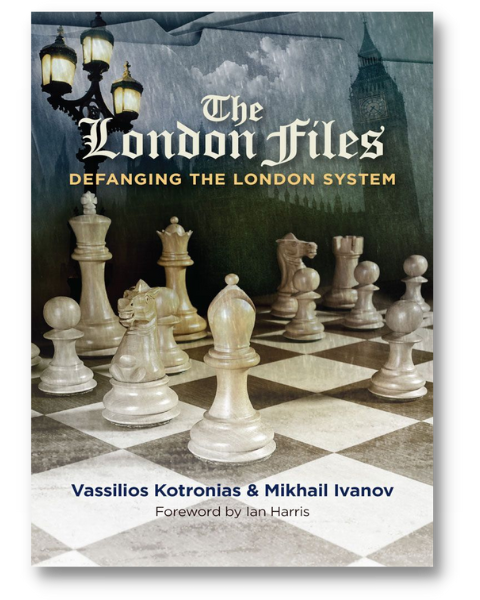Oh, no! Not the London System!
I am sure most players feel the same when the opponent bypasses so much mainline theory by opting for what is often classed as a boring opening.
In reality, the London System is not boring at all and is impossible to refute. After all, White’s early moves are all designed to develop their pieces to good squares, castle the king into safety, and stifle any attempts by the second player to drag the game into their own specialist territory. That all sounds like a very good way to play and there is little wonder the club player’s favorite opening has enjoyed an explosion of popularity, even at the highest of levels, especially those featuring faster time limits.
In The London Files, Vassilios Kotronias and Mikhail Ivanov aim to arm Black with new ideas to face the dreaded Bf4 systems whether the first player opens with 1. d4 2. Nf3 3. Bf4 or the trendier 1. d4 2. Bf4.

In fact, to cater for all styles of play, the authors provide no fewer than four anti-London methods, namely:
(1) King’s Indian Setups
(2) London Benoni
(3) London Nimzo- and Queen’s Indian
(4) London Orthodox System
The book will obviously guide players through everything they need to know in order to combat the London System in any style they choose, but I am sure all anyone is interested in at the moment is to see a few choice moments when everything goes right for the second player and the London System falls down.
1. King’s Indian Setups
Our first position is from the King’s Indian approach.
Note that White has declined to play an early h2-h3 in this instance (an automatic move for London players on autopilot) and is hoping the tempo can be put to better use by the early c2-c4 instead.
Yet Black has a very strong idea here, which has been unearthed by the authors of this book.~
7…e5!!
8. dxe5 Ne4!
Black is suddenly better, after only eight moves! The famous King’s Indian bishop is already breathing tactical fire down the long diagonal and White already has to tread a very fine line just to stay afloat.
2. London Benoni
Here is the Benoni system in action.
After 1. d4 Nf6 2. Bf4 c5 3. d5 Black can really make White think by playing 3…b5!, which is, of course, a thematic Benoni move, but exactly the sort of thing London players think they are going to avoid meeting when they think they can trot out the same old moves game after game.
(In passing, it is also worth mentioning that 1. d4 c5! is also an excellent way of confusing club players who don’t want to think for themselves too early in the game.)
After 3…b5!, remarkable as it seems, the d5-pawn may end up in mortal danger, because …Bb7 will be coming soon and White needs to take appropriate action to avoid an opening disaster.
3. London Nimzo- and Queen’s Indian
Next, we see the Nimzo/Queen’s Indian method turning out very successfully.
This looks to be heading straight into White’s dreams, but even here there is an interesting way to throw the first player back onto his own resources.
4…Ba6!?
What a difference one square makes! White may have expected the typical Queen’s Indian development with 4…Bb7, but 4…Ba6!? asks significant questions about White’s future intentions, as e2-e3 is suddenly desirable. Furthermore, 5. Nbd2 c5! continues to ask the questions and White will almost certainly be in an unfamiliar position (which is exactly where we want them to be).
4. London Orthodox System
Finally, Black’s last triumph to be featured in this particular blog post is the result of the second player sticking to an orthodox way of playing; the very path White players are hoping to see when they develop their bishop to f4, in the hope of a straightforward game in which they plan to keep control of the position and utilize their slight edge.
Play could start with 1. d4 d5 2. Bf4 but Black (once again) throws an early spanner in the works with 2…c5.
White now has three main options: 3. dxc5, 3. c3 and 3. e3.
Most players will be reluctant to give up the center with 3. dxc5 – and rightly so. 3. c3 runs into 3…Qb6! when Black is already probing the dark squares on the queenside, which have been deserted by 2. Bf4. Meanwhile, 3. e3 (the most popular option) allows Black to head for a transposition to the Exchange Variation of the Caro Kann Defense with 3…cxd4 4. exd4 Nc6, which is easy enough for Black to play with just a little preparation and a basic understanding of the position.
Put yourself in White’s shoes. All you want to do is play the first 10 or so moves quickly, without having to think. Yet using the lines recommended in this book, Black will be able to change the course of the game as early as the second move and drag White into quite different territory. Well-prepared players with the black pieces will suddenly be very pleased indeed to see the first player reaching for the c1-bishop!
Sean Marsh
- Dover Books are finally here! - November 20, 2024
- Book Review: Moves 3 to 10 by Nery Strasman - August 9, 2024
- The Life and Games of Dragoljub Velimirovic (Volume 2) by Georg Mohr and Ana Velimirovic-Zorica - July 23, 2024
